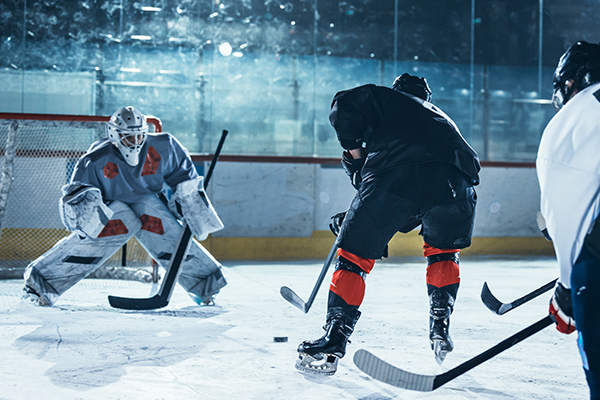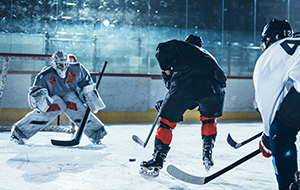
Ice hockey is a thrilling sport that demands speed, agility, and physicality. However, this brings a risk of injuries ranging from muscle strains to concussions. Let’s explore the common injuries in hockey, their treatment options, and prevention strategies to ensure athletes can safely enjoy the sport they love.
Common Acute Injuries:
- Shoulder Injuries: Collisions can lead to shoulder dislocations, AC joint injuries, or broken collar bones. Treatment may involve immobilization, physical therapy, or surgery for severe cases.
- Knee Injuries: High speed stops and starts can lead to MCL and ACL tears. Twisting movements can lead to meniscus tears.
- Wrist Fractures: Falling on an outstretched hand can break the wrist, necessitating casting or surgical intervention.
- Concussions: They are a serious concern in contact sports and require immediate attention. Rest and a gradual return to play are crucial.
Overuse Injuries:
- Groin Strains: Frequent skating can strain the groin muscles. Rest, ice, compression, and elevation (RICE) are first-line treatments, followed by strengthening exercises.
- Hip Labral Tears: Repetitive movements can tear the hip labrum. Physical therapy or arthroscopic surgery might be recommended.
- Shin Splints: Overuse can cause pain along the shin bone. Rest and proper footwear are essential for recovery.
Effective Treatment Options:
- Immediate First Aid: Promptly addressing injuries with basic first aid techniques, such as applying ice packs and stabilizing the affected area, can help reduce swelling and pain.
- Professional Medical Evaluation: Seeking medical attention from a sports medicine physician or orthopedic specialist is crucial for accurate diagnosis and personalized treatment plans.
- Physical Therapy: A cornerstone of injury management, it helps restore function and prevent future injuries.
- Surgery: For severe injuries, surgical repair is sometimes the best option to return to play. It may be performed minimally invasively using arthroscopy or as an open surgery.
- Preventive Measures: Proper equipment, warm-up routines, and strength training can reduce the risk of injuries.
Rehabilitation and Return to Play
A tailored rehabilitation program is vital for a safe return to the ice. It should address the specific needs of the injury and the player's position. Gradual reintroduction to skating and contact drills is essential to ensure full recovery.
Understanding the nature of hockey injuries and implementing effective treatment and prevention strategies can help players stay safe on the ice. If you're dealing with a hockey-related injury, consult with an orthopedic specialist to receive personalized care and get back to your game with confidence.
At NJOI we pride ourselves on offering our patients the most advanced, least invasive treatment options available. Make an appointment today.
AUTHOR:
Michael K. Shindle, M.D., is a Board Certified Orthopedic Surgeon in Sports Medicine at the New Jersey Orthopaedic Institute. Dr. Shindle has experience as a Team Physician for the National Hockey League New Jersey Devils, Orthopedic Consultant for the National Football League New York Giants, Team Physician for the Major League Soccer New York Red Bulls, Team Physician for USA Hockey, Team Physician for US Men’s Soccer.





